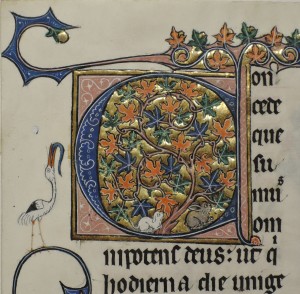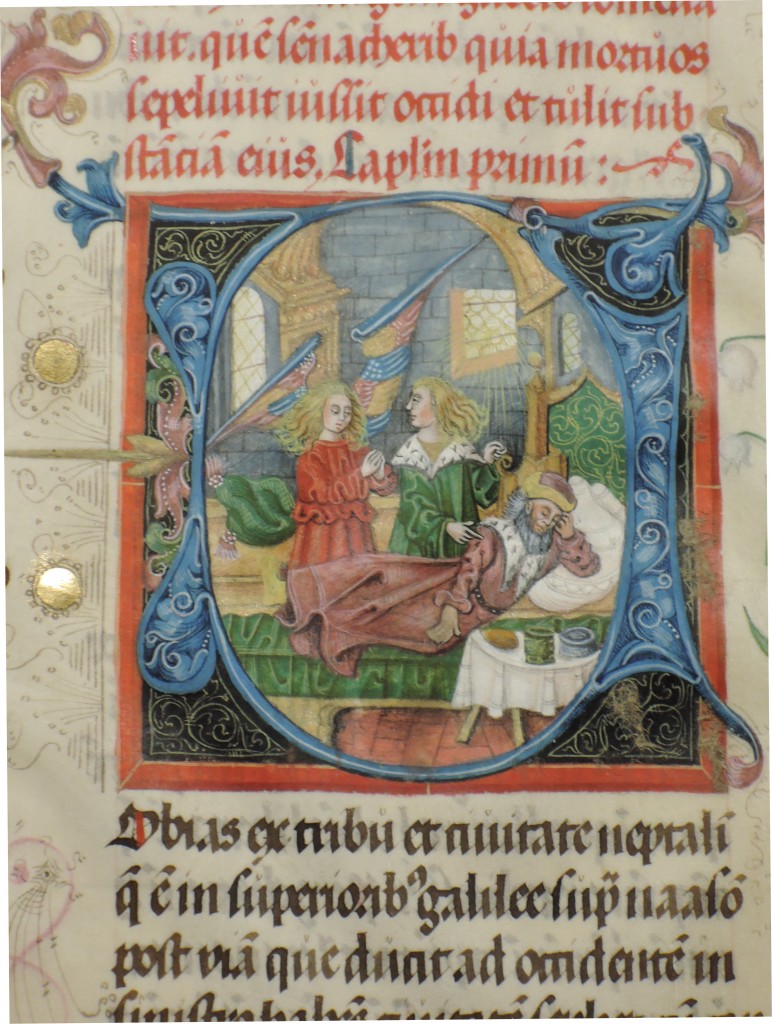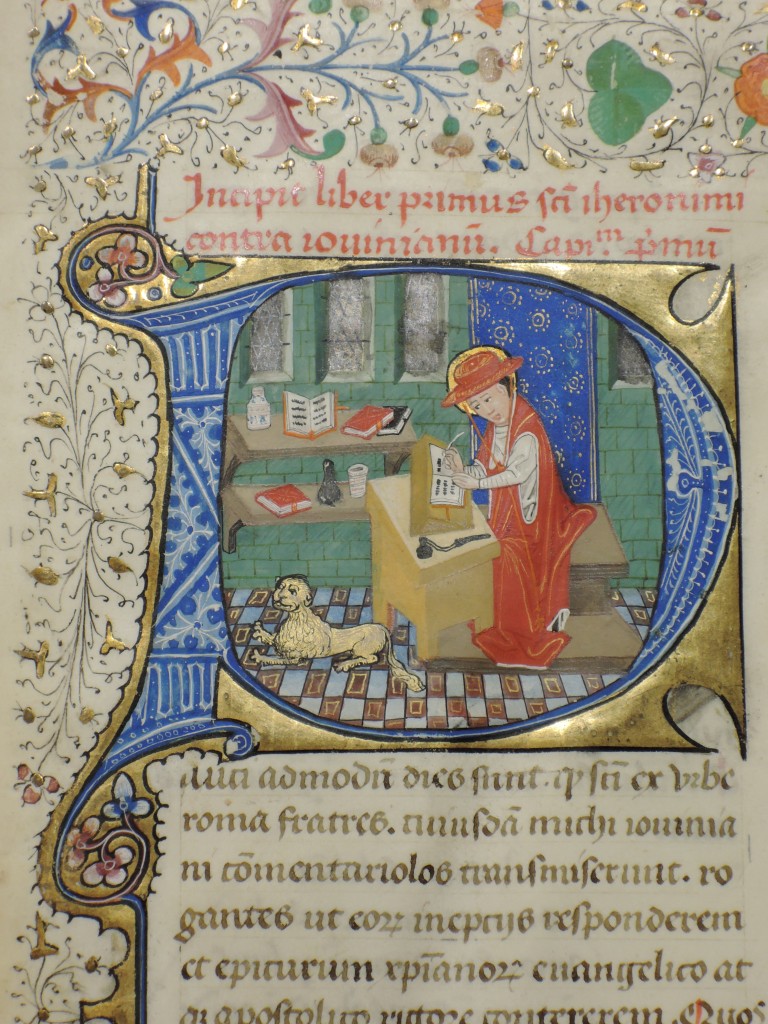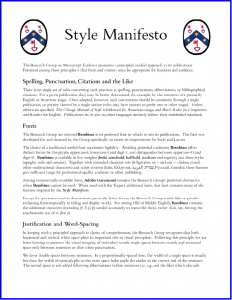2016 Symposium on ‘Words & Deeds’
February 1, 2016 in Bembino, Conference Announcement, Events

Initial C of Concede. Detail from a leaf from ‘Otto Ege Manuscript 15’, the ‘Beauvais Missal’. Otto Ege Collection, Beinecke Rare Book and Manuscript Library, Yale University. Photograph by Lisa Fagin Davis. Reproduced by Permission
Words & Deeds
Actions Enacted, Re-Enacted & Restored
From Late-Antique Theater to the Legacy of Otto Ege
by way of, inter alia, Saint-Denis and Gutenberg
A Symposium of the Research Group on Manuscript Evidence
Friday & Saturday, 25–26 March 2016
106 McCormick Hall
Princeton University
Sponsors
The Research Group on Manuscript Evidence
The Department of Art & Archaeology, Princeton University
The Index of Christian Art at Princeton University
James Marrow & Emily Rose
Barbara A. Shailor
The Samuel H. Kress Foundation
The Schoenberg Institute for Manuscript Studies
We announce a Symposium to be held at Princeton University on 25 & 26 March 2016. Organized by our Director, Mildred Budny, this event launches our activities for 2016. Next in line come our Sessions and Activities, both sponsored and co-sponsored, at the 51st International Congress on Medieval Studies in May.
[Update: Now see the Symposium Report, and the downloadable illustrated Program Booklet with the Abstracts of Papers, set in RGME Bembino and laid out according to our Style Manifesto.]
Themes & Variations

Illustrated initial T for Tobias with Tobias and the Angel, on a leaf from ‘Otto Ege MS 44 (FOL 44)’, Volume I of a Lectern Bible made in Germany, Austria, or Bohemia, and dated 1507. Otto Ege Collection, Beinecke Rare Book and Manuscript Library, Yale University. Photograph courtesy Lisa Fagin Davis. Reproduced by permission.
Our symposium engages with the realms of documents, seals, seal matrices, and other means of authentications or attestations, regarding deeds in material forms as well as deeds in action. Chronicles, biographies, and other narratives (both real and imagined) have their part in the story, too, along with illustrations of events and inscriptions in a variety of media. The interrelationship, or tensions, between words and events come into focus as well. The span for consideration welcomes a range of dates, languages, regions, materials, forms of activities, and interactions – harmonious or otherwise.
Likewise, we address issues posed by objects which carry within the confines of their present borders most of the evidence, apparently, to reveal their purposes through words and/or images. Such is the case, poignantly, given the vagaries of history (from whatever causes, natural or not), with fragments dispersed from former whole objects or groups of objects, from collections or sites to individual monuments.
The sessions will focus on these and other predicaments, challenges, and opportunities.
For example, some speakers focus on the complex achievements of the Abbey of Saint-Denis in its creation of an exceptional identity. Others celebrate the research and discoveries facing the study and recovery of manuscript remnants from the collection of Otto F. Ege, especially the trove newly acquired from his descendants at the Beinecke Library of Yale University. Approaches to assessing, representing, and understanding the material evidence of manuscripts in digital forms are surveyed also in reports on new developments at The Schoenberg Institute for Manuscript Studies.
Subjects for consideration range from the evidence for experiencing the theater in Late-Antiquity and the paradox of ‘deadly love’ in Western Christian Medieval liturgy, through amulets and sealed medieval deeds, to the lost Hortus deliciarum (‘Garden of Delights’), the bronze doors of Abbot Suger at Saint-Denis, and papal indulgences printed on the Gutenberg press before the Gutenberg Bible. A Round Table discussion will explore experts’ experiences and views about these and related issues.
Speakers, Moderators & Panelists
Charles E. Barber (Department of Art & Archaeology, Princeton University)
Elizabeth A.R. Brown (The City University of New York Emerita)
Mildred Budny (Research Group on Manuscript Evidence)
Sarah Celentano (Art and Art History Department, University of Texas at Austin)
Celia Chazelle (Department of History, The College of New Jersey)
Raymond Clemens (Beinecke Library, Yale University)
Giles Constable (School of Historical Studies Emeritus, Institute for Advanced Study)
Lisa Fagin Davis (The Medieval Academy of America)
Jessie Dummer (Schoenberg Institute for Manuscript Studies, University of Pennsylvania Libraries)
Catherine Fernandez (Index of Christian Art)
Paula Gerson (Department of Art History, Florida State University Emerita)
Beatrice Kitzinger (Department of Art & Archaeology, Princeton University)
Genevra Kornbluth (Kornbluth Photography)
Karl F. Morrison (Rutgers University Emeritus)
Pamela Patton (Index of Christian Art)
Katherine Philbin (Simmons College)
Dot Porter (Schoenberg Institute for Manuscript Studies)
Lynn Ransom (Schoenberg Institute for Manuscript Studies)
Henry Schilb (Index of Christian Art)
Barbara A. Shailor (Yale University)
Alan M. Stahl (Firestone Library, Princeton University)
Thomas G. Waldman (Department of History, University of Pennsylvania)
Andrew Walker-White (School of Arts and Science, Stratford University)
Eric White (Firestone Library, Princeton University)
Times & Directions
The event is announced on the Current Calendar of the Program in Medieval Studies at Princeton University, with a Provisional Program. The updated Program can be downloaded here.
The Sessions will take place in 106 McCormick Hall, on the ground floor. On Friday, with breaks for coffee/tea and lunch, the Sessions will run from 9:00 am to 5:30 pm, followed by a Reception from 5:50 to 7:00 pm in the Index of Christian Art, also located in McCormick Hall, on the lower floor. Lunch on Friday will take place in the 3rd Floor Lounge at McCormick Hall, at a charge of $10 per person. The Sessions on Saturday, with a break for coffee/tea, will run from 9:00 am to 12:30 pm. All are welcome.
Resources online for planning your visit to Princeton, including directions, public transportation, parking, and campus maps, appear here. We look forward to seeing you.
Please let us know if you will attend. You could Contact Us via [email protected].
Exhibition
An accompanying exhibition, curated by Jessica Savage (Index of Christian Art), will display newly selected materials from the archives of Charles Rufus Morey at the Index of Christian Art. It focuses on ‘Words & Deeds of Charles Rufus Morey at the American Embassy in Rome (1945–1950)’. Exhibition Notes will appear in the Symposium Program Booklet.
The exhibition can be viewed during the open hours of the Index, from 9:00 am to 5:00 pm on Mondays to Fridays, and during the Reception for our Symposium (5:30 to 7:00 pm on Friday 25 March).
*****
Thanks
We give thanks to the Hosts, Sponsors, Advisers, Organizer, and Contributors!
*****
Previews
As the Symposium approaches, we offer some background to highlight the subjects which speakers and panelists will address. First:
A Note on the Otto Ege Connection

The illustrated opening initial P for Pauci, with the scribal author Jerome, plus lion, on a leaf from ‘Otto Ege Manuscript 35’, made in France in the mid 15th-century. Otto Ege Collection, Beinecke Rare Book and Manuscript Liibrary, Yale University. Photograph by Lisa Fagin Davis. Reproduced by permission.
Perhaps you have heard of the manuscripts collected by Otto F. Ege? Are you wondering about the Ege Manuscripts and their dispersal? Welcome to the club!
Several blogposts last year by Mildred Budny for our Manuscript Studies blog offer case studies for some of them, as part of our on-going work of conservation, photography, and research.
- Lost and Foundlings
The Case of Otto F. Ege as Collector and Despoiler - A New Leaf from ‘Otto Ege Manuscript 8’
Part of a Processional for Nuns for Palm Sunday - A New Leaf from ‘Otto Ege Manuscript 14’
Part of the Interpretation of Hebrew Names from a 50-line Lectern Bible in the Vulgate Version - A New Leaf from ‘Otto Ege Manuscript 41’
Part of the Dialogues of Gregory the Great - A New Leaf from ‘Otto Ege Manuscript 61’
Part of Ezekiel from a 32-line Latin Vulgate Pocket Bible from France
You might see why we look forward to this Symposium with such great interest and excitement at the revelation of many discoveries in several centers.
For years now, we have been eagerly following the unfolding discoveries about the Ege materials dispersed in many collections, as reported by, among others, our Associates Barbara A. Shailor, Judith Oliver, Scott Gwara, and Lisa Fagin Davis. The bibliography on the subject is large, and growing. (Our blogposts cite many examples.)
Highlights include
- Barbara’s on-going work on, and on behalf of, Ege materials, as in ‘Otto Ege: His Manuscript Fragment Collection and the Opportunities Presented by Electronic Technology’ (2003)
- Scott’s informative book on Otto Ege’s Manuscripts: A Study of Ege’s Manuscript Collections, Portfolios, and Retail Trade, with a Comprehensive Handlist of Manuscripts Collected or Sold (2013)
- Lisa’s ground-breaking reconstructions of the 13th-century Beauvais Missal (‘Ege Manuscript 15’), revealed in stages in her Manuscript Road Trip blog, and demonstrated in evolving form through Reconstructing the Beauvais Missal.
(A detail from this superbly beautiful manuscript appears at the top of this post.) - Recent collaborative advances for another, 15th-century, case, that of Reconstructing Ege FOL 47, by Lisa Fagin Davis and others, including Katherine Philbin, who will speak at our Symposium.
At our Symposium, Barbara Shailor’s Session on ‘Words & Misdeeds: The Ege Family’s Commitment to Manuscript Studies’ considers the recent acquisition of materials from the Otto Ege Family by the Beinecke Library of Yale University. This transfer is reported in several press releases:
- Beinecke Library acquires ‘treasure trove’ of medieval manuscripts from Otto Ege
- Yale Buys Collection of Scattered Manuscript Pages.
Riches indeed!
Fragments as Essence, and the Recovery of Evidence
While new and on-going research makes strides in the study of fragments — to which category belong most materials from the late-antique and medieval worlds (among others), even if the objects themselves might survive more-or-less intact — we aim for integrated studies, as the new field of ‘Fragmentology’ might be, rather than fragmented studies as such. Hence our gathering of scholars in wide-ranging fields, with many points of potential overlap.
At our Symposium, we look forward to hearing about work and work-in-progress in multiple fields, to compare notes, gather feedback, and consider the prospects. Please join us!
*****
We thank our Speakers, Moderators, Panelists, and Sponsors for their generous contributions to this event.
We thank Barbara Shailor, Lisa Fagin Davis, and Raymond Clemens for providing images of materials in the Otto Ege Collection. We thank them and the Beinecke Rare Book and Manuscript Library, Yale University, for granting permission to use the images in announcing the Symposium.
Please watch this space for updates.
Look for the Posters for the Symposium, illustrated with photographs by Lisa Fagin Davis, designed according to our Style Manifesto, and laid out in our copyright font Bembino.
You may Subscribe here for our RGMEnewsletter ShelfMarks and for announcements of our activities.
We invite Contributions & Donations in various forms (in funds and in kind) to sustain our activities, conduct our research work, accomplish our publications, and prepare the next events.
To ask for further information about this Symposium, and to let us know if you plan to attend, please contact the [email protected].
We look forward to seeing you there.
*****
[Published on 1 February 2016, with updates. See also the 2016 Symposium Report and the downloadable Program Booklet.]


[…] Words and deeds. Actions enacted, re-enacted, and restored (Princeton [NJ], Princeton University) http://manuscriptevidence.org/wpme/2016-symposium-on-words-and-deeds/ […]